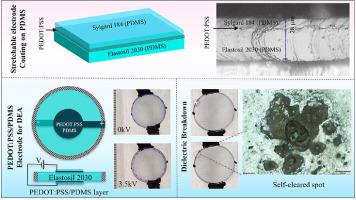Sensors and Actuators Reports Pub Date : 2023-05-19 , DOI: 10.1016/j.snr.2023.100162 Milan Shrestha , Leonardus Depari , Maziar Shakerzadeh , Ranjana Shivakumar , Edwin H.T. Teo

|
Polydimethylsiloxane (PDMS) is widely used as the substrate for wearable sensors and elastomeric actuators because of its good dielectric property, stretchability, thermal/chemical resistance, biocompatibility, and transparency. PDMS-based stretchable sensors and electroactive actuators need a coating of thin compliant electrodes. However, PDMS is hydrophobic with water contact angle above 120°. Such low surface energy of PDMS creates issues for uniform coating of ink-based electrodes and/or their adhesion. Similarly, metal thin-film or nanowire-based materials coated on PDMS easily peels off. Surface treatments like UV/plasma exposure can temporarily increase PDMS's surface energy. However, these surfaces return to its original state within hours leaving behind a brittle surface layer that cracks upon stretching. To address these issues, we formulated a viscous composite ink with PEDOT:PSS and PDMS that can easily be coated on untreated PDMS by blade casting, screen printing, and so on. These coatings are highly transparent, stretchable, electrically conductive and work as compliant electrodes. We fabricated transparent dielectric elastomer actuators by coating PEDOT:PSS/PDMS composite ink on Elastosil (PDMS) substrates. The actuation strain and breakdown-fields were slightly lower compared to DEA with conventional graphite electrodes. However, the additional self-clearing capability of PEDOT:PSS/PDMS electrodes enhanced robustness of the DEA in events of localized dielectric breakdown.
中文翻译:

基于墨水的透明顺应电极,用于在未经处理的疏水性 PDMS 表面上直接涂层
聚二甲基硅氧烷 (PDMS) 因其良好的介电性能、可拉伸性、耐热/耐化学性、生物相容性和透明性而被广泛用作可穿戴传感器和弹性体致动器的基材。基于 PDMS 的可拉伸传感器和电活性执行器需要一层薄的柔顺电极。然而,PDMS 是疏水性的,水接触角大于 120°。PDMS 的这种低表面能对墨基电极的均匀涂层和/或其附着力产生了问题。同样,涂在 PDMS 上的金属薄膜或基于纳米线的材料很容易剥落。紫外线/等离子曝光等表面处理可以暂时增加 PDMS 的表面能。然而,这些表面会在数小时内恢复到原来的状态,留下一层易碎的表层,在拉伸时会开裂。为了解决这些问题,我们用 PEDOT:PSS 和 PDMS 配制了一种粘性复合油墨,可以很容易地通过刮刀浇铸、丝网印刷等方式涂覆在未经处理的 PDMS 上。这些涂层高度透明、可拉伸、导电,可用作顺应性电极。我们通过在 Elastosil (PDMS) 基板上涂覆 PEDOT:PSS/PDMS 复合油墨来制造透明介电弹性体致动器。与使用传统石墨电极的 DEA 相比,驱动应变和击穿场略低。然而,PEDOT:PSS/PDMS 电极的额外自清除能力增强了 DEA 在局部介电击穿事件中的稳健性。导电并用作顺应性电极。我们通过在 Elastosil (PDMS) 基板上涂覆 PEDOT:PSS/PDMS 复合油墨来制造透明介电弹性体致动器。与使用传统石墨电极的 DEA 相比,驱动应变和击穿场略低。然而,PEDOT:PSS/PDMS 电极的额外自清除能力增强了 DEA 在局部介电击穿事件中的稳健性。导电并用作顺应性电极。我们通过在 Elastosil (PDMS) 基板上涂覆 PEDOT:PSS/PDMS 复合油墨来制造透明介电弹性体致动器。与使用传统石墨电极的 DEA 相比,驱动应变和击穿场略低。然而,PEDOT:PSS/PDMS 电极的额外自清除能力增强了 DEA 在局部介电击穿事件中的稳健性。



























 京公网安备 11010802027423号
京公网安备 11010802027423号